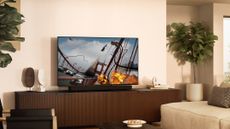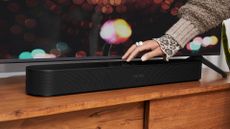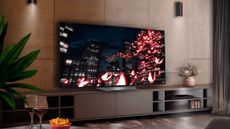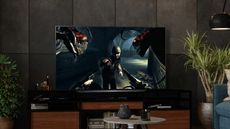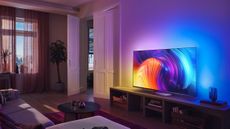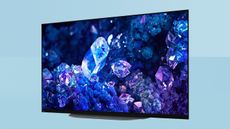This year, the ranks of the best OLED TVs will finally include 42-inch 4K OLED TVs for the first time, which I'm over the moon about. So many people can only fit one of the best 40, 42 or 43-inch TVs in their room, but there's been a frustrating cap on how premium the screen quality for these TVs has been – they've basically been left in the mid-range, and they shouldn't have been. People with small-to-medium spaces love high-quality HDR too!
Happily, this year both the LG C2 and Sony A90K OLED TV ranges will come in 42-inch sizes – and I had the chance to take a look at them both thanks to AWE Europe, which distributes TVs, audio equipment, projectors and smart home gear for custom installations.
Both models are made with the same OLED panel (manufactured by LG Display), but beyond that they're different in design, processing and even how they handle the panel. I didn't have enough demo time to really dig into where each one will shine, but the main thing is that I got see whether the OLED experience comes through in the smaller screen.
And the most important part absolutely does: the thing you notice immediately about both models is the perfect black tones they can reproduce, as you expect from OLED TVs.
It's nothing we haven't seen on larger TVs, but I've never seen it on something this size before – it makes you realise how much we associate certain looks with differently sized screens. All 43-inch LCD screens have been LCD, and rarely with full array backlights or lots of dimming zones – even the Samsung The Frame 43-inch, which is one of the best options, still can't truly go black in limited zones.
On the LG C2, I watched LG's art mode slide images across the screen, including a hard square of black inching smoothly across, overlapping with brighter pictures, and with no leak between them, which was the best single demonstration I saw of something that simply wasn't possible in other smaller TVs.
Naturally, both screens really impressed with detail, since they're each packing a very high-end processor, and are fitting 4K images into a smaller space than bigger 4K TVs, meaning a higher pixel density.
However, that pixel density comes at a price: these smaller TVs don't seem to have the same HDR visual pop as the latest and greatest larger OLED sets. This is a known thing – LG has said that the "pixel pitch", as it's known, means that they're essentially the same brightness as previous-generation OLED TVs, rather than seeing the roughly 20% higher brightness that the 55-inch models and up are expected to deliver.
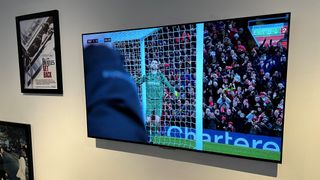
The LG C2 is such a polite size, fitting neatly on a gallery wall if you wanted, or just generally taking little space thanks to its thin footprint and minimal bezel.
Of the two, the Sony A90K looked to have a noticeable step more HDR punch to it than the LG C2 during my brief demo time – and Sony has said that it's including specific temperature management tech that may mean it's able to push brightness further than LG is, but we'll have to wait until our full review for testing that in practice – my observation is just subjective from the demo time I had.
I didn't get to test their audio systems meaningfully, but the Sony also promises better built-in sound from its Acoustic Surface Audio+ system, but again we'll test that when we're able.
There's not much between them when it comes to design, either – you get a single central stand from the Sony, while the LG has two feet. The LG looks slightly better suited to wall-mounting without a big gap between screen and wall.
I'm not going to make any big judgment about these TVs from the time I've had so far, but my takeaway is that for light-controlled rooms, they look like they'll really deliver on the promise of small-screen OLED – stunning darkness and precise contrast, tons of detail and smooth motion control.
But the limited brightness compared to newer large OLED sets means that for bright rooms – whether that's a kitchen, or a bedroom/living room where you'll often watch with sunlight streaming in, you might be better off looking at the brighter LCD competition, which will cut through ambient light better.
I'm really looking forward to spending more time with both – the Sony A90K has the edge on excitement for me right now, but there's all to play for in this lightweight OLED head-to-head fight for a place in our list of the best TVs. A 2022 champion will emerge once we're ready with our full reviews…




